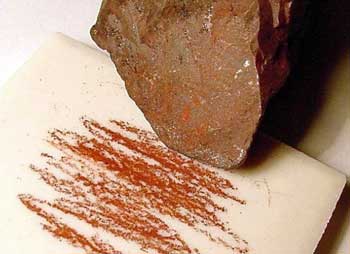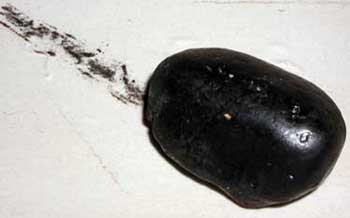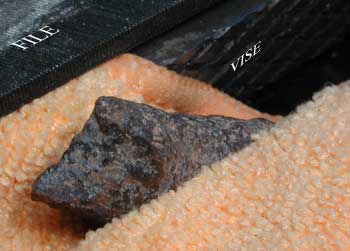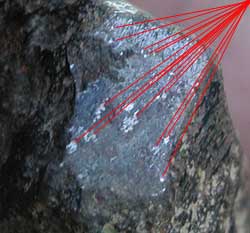Suspect Meteorite Tests
|
APPEARANCE |
There are three classes of meteorites: stony, iron, and stony-iron. A meteorite is heavier than an ordinary rock and will be attracted to a magnet. The condition of a meteorite can range from fresh to very weathered. Fresh meteorites have fusion crust, an aerodynamic shape and possibly thumbprints (regmaglypts). Weathered meteorites may be more difficult to recognize due to the deterioration of its' meteoritic properties.
To familiarize yourself with meteorite and meteor-wrong appearances, see "You think you have found a meteorite?"
Note: This website only addresses identification of common meteorites.
|
MAGNETIC TEST |
99% of all meteorites are attracted to a strong magnet. (As are metal artifacts, slag and iron ore) Or if the object is small, hang it or the magnet from a string. This is used as a preliminary test and is recommended to new collectors. If your specimen does not pass this test it is probably NOT a common meteorite!
Note: Samples passing this test are not necessarily meteorites.
 |
Test Specimen - No crust, magnetic |
|
STREAK TEST |
Iron ore is the most common meteor-wrong. Magnetite especially is very magnetic (hence its name) and hematite may or may not be mildly magnetic. Both these minerals may possibly be distinguished from meteoritic material by a characteristic known as 'streak'. You can test the streak very simply. If you take a common ceramic tile, such as a bathroom or kitchen tile, it has a smooth glazed slide and an unfinished dull side which is stuck to the floor/wall when installed. Take the sample which you think is a meteorite and scratch it quite vigorously on the unglazed side of the tile.
If it leaves a black/gray streak (like a soft leaded pencil) the sample is likely magnetite, and if it leaves a vivid red to brown streak it is likely hematite. A stone meteorite, unless it is very heavily weathered will not normally leave a streak on the tile.
You say that you don't have a ceramic tile? You can use the bottom of an ceramic coffee cup or you can also use the inside of your toilet tank cover. (the heavy rectangular lid on top of the tank) It is very heavy, so be careful.
Note: Samples passing this test are not necessarily meteorites. Also, I have had some heavily weathered stone meteorites that leave a slight gray streak so be sure you streak a sample representative of the interior.
 |
 |
hematite streaks red |
magnetite streaks black |
|
WINDOW TEST |
Here is the test you wanted to avoid. If your stone specimen passed the magnet test, it is time to make a small window to see inside. Yes, I know you fear damaging your suspect meteorite but this is necessary and will not decrease the value. The goal is to use a file to grind flat a corner or appropriate area on the stone. If the specimen is small and you have a bench vice or vicegrip, wrap the specimen in a cloth and secure it so you can file a window. Filing will take some effort. (if this is beyond your abilities - see professional testing) Look at the cut surface from several different angles, if you can see shiny metal flakes scattered throughout the stone, it may well be a meteorite. If the interior is plain then it is probably a wrong.
Note: Samples passing this test might be meteorites.
 |
 |
Test Specimen in vise |
Test Specimen - shiny metal flakes visible in 'window' ( a meteorite!) |
|
NICKEL TEST |
All iron meteorites contain nickel. Most stone meteorites contain nickel. Thus, a chemical test for nickel in normal meteoritic proportions is definitive for meteorites in most cases. Caution should be taken when acid is used in the test. Helpful info on using this test.
Note: Samples passing this test might be meteorites. Warning:(1) slag can test positive and (2) R. Korotev relates "if the pink color fades away after 5 minutes, then the metal contains Ni, but not enough to be of meteoritic origin."
|
DENSITY & SPECIFIC GRAVITY |
If you are able to calculate the density of your suspect meteorite, that information may help you to identify it. Washington University in St. Louis (WUSTL) has a fine page covering Density and SG.
Cascadia's Interactive Meteorite Identification. For more photos of meteor-wrongs see the WUSTL Photo Gallery
|
VIDEOS |
McCartney Taylor reviews some of the above steps with you!
Stone Meteorite Identification
.
Randy L. Korotev - Meteorites and Meteorwrongs
Professor Chris Herd, resident meteorite expert and curator of the University of Alberta Meteorite Collection
Also see: How to Identify a Meteorite